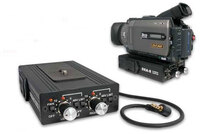![]() HDSLR, small format digital video camcorders and pocket digital audio recorders are being used ever increasingly for professional application. In addition, there are still those rare occasions when we encounter the older video formats, such as mini DV, Digital 8, Hi8mm, and even SVHS.
HDSLR, small format digital video camcorders and pocket digital audio recorders are being used ever increasingly for professional application. In addition, there are still those rare occasions when we encounter the older video formats, such as mini DV, Digital 8, Hi8mm, and even SVHS.
The various merits of shooting images with these relatively inexpensive, unobtrusive, and extremely portable video acquisition systems are familiar to most readers. However, interfacing these consumer and prosumer camcorders with professional audio can be a nightmare.
 For example, when you use the consumer shotgun mic that came with the camera (or was sold for it as an aftermarket accessory), the audio sounds clean. Not great, but free of excessive static and electronic residue. However, when you try to plug in your thousand dollar professional microphone, the result is a lot of buzz, hum, and lower audio levels. Why should better equipment make more noise than the cheap stuff that came with the camera?
For example, when you use the consumer shotgun mic that came with the camera (or was sold for it as an aftermarket accessory), the audio sounds clean. Not great, but free of excessive static and electronic residue. However, when you try to plug in your thousand dollar professional microphone, the result is a lot of buzz, hum, and lower audio levels. Why should better equipment make more noise than the cheap stuff that came with the camera?
Let's examine why this happens and how to fix it.
Most camcorders will readily accept the industry standard 250 ohm low-impedance microphone input signal, so the problem is not that of matching impedance level so much as it is a question of proper input cables. Purchasing an impedance matching device is not the solution to your problem, even though the salespeople at consumer camera outlets will try to convince you that it is. Trust me, it is NOT about the impedance.
The mic input for these consumer camcorders is generally a 3.5mm (aka 1/8 inch) stereo mini jack. The output of a professional grade microphone is XLR 3-pin. Therefore, the first task at hand is to adapt XLR 3-pin output to mini stereo input. To do that, we need an adapter cable that consists of a female XLR 3-pin connector at one end feeding a mini stereo plug at the other.
Since the camcorder input is stereo, our adapter cable needs to split the incoming monaural audio over both the left and right camcorder channels. If we were to record onto only one channel, we risk serious damage to our soundtrack.
The second, empty, channel would fill with hiss and noise. When our audio is transferred from analog video for post-production, a percentage of this noise will most likely bleed into the good channel. Such is the nature of consumer audio/video, due to the proximity of the recording circuits and head placement.
Some lower end digital devices also suffer from track bleed, though not as much. It depends on the quality of the electronics and the physical separation of the wires & components.
In addition to audio bleed, the presence of an empty track may cause confusion or even havoc with the automatic gain control in the camcorder. Even those cameras that offer a manual audio level control will revert to auto gain if the power is turned off, tape changed, or battery changed. Unless you are meticulous, the resumption of video recording may be with auto gain ON.
Finally, recording to just one camcorder channel makes it difficult to monitor some meter levels and to hear with both sides of the headphones (unless you use cumbersome adapters with your headphones).
Bottom line: Always feed the Left and Right camcorder channels, either with monaural audio going to both sides, or with discreet stereo audio going onto respective Left and Right. Never assume that what is on the second channel will not show up in some form on your first channel, so be very careful if recording wild questions or cue tracks that you plan on editing out.
